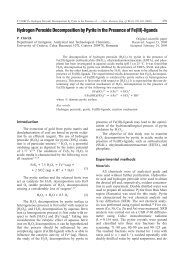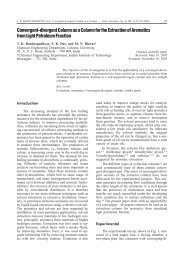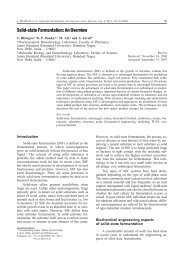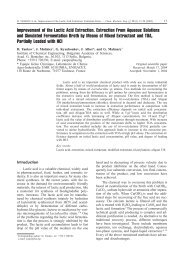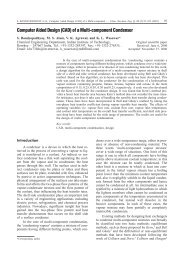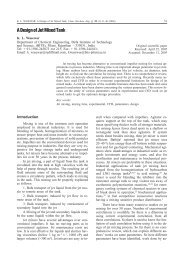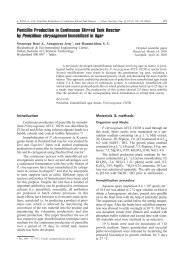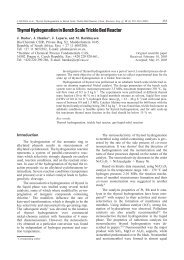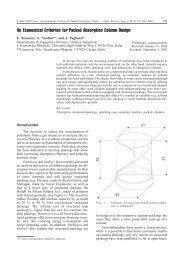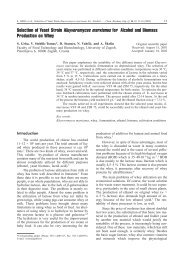Modular-Based Modelling of Protein Synthesis Regulation
Modular-Based Modelling of Protein Synthesis Regulation
Modular-Based Modelling of Protein Synthesis Regulation
You also want an ePaper? Increase the reach of your titles
YUMPU automatically turns print PDFs into web optimized ePapers that Google loves.
214 G. MARIA, <strong>Modular</strong>-<strong>Based</strong> <strong>Modelling</strong> <strong>of</strong> <strong>Protein</strong> <strong>Synthesis</strong> <strong>Regulation</strong>, Chem. Biochem. Eng. Q. 19 (3) 213–233 (2005)<br />
cell cycle. The paper exemplifies how such a methodology<br />
should be used to step-by-step build-up<br />
a regulatory chain, and how the feasibility and effectiveness<br />
<strong>of</strong> the (cooperatively-linked) modular<br />
construction can be checked in every modelling<br />
step by means <strong>of</strong> P.I.-s.<br />
The modelling framework uses continuous-variable<br />
ordinary differential (ODE) kinetic<br />
models to check the synthesis regulatory efficiency,<br />
by explicitly accounting for cell-volume variation<br />
during the cell cycle, protein interactions and regulatory<br />
loops under stationary and dynamic environmental<br />
perturbations. The more realistic modelling<br />
approach allows an accurate evaluation <strong>of</strong> the individual<br />
effector/unit relative importance, perturbation<br />
propagation inside a cell, and the influence <strong>of</strong><br />
module type and enzyme activity allosteric control<br />
on its regulatory P.I.-s. Once the methodology elaborated,<br />
such a cell modelling platform can be detailed<br />
and used to simulate complex protein / species<br />
interactions, cooperative regulation <strong>of</strong> the<br />
metabolic synthesis, and other processes during the<br />
cell growth.<br />
<strong>Modelling</strong> metabolic regulation –<br />
A short review<br />
<strong>Protein</strong> synthesis by gene expression is a<br />
highly regulated process which ensure a balanced<br />
and flexible cell growth under an indefinitely<br />
variate environmental conditions. How this very<br />
complex process occurs is partially understood, but<br />
a multi-cascade control with negative feedback<br />
loops seems to be the key element. 6–9 Enzymes<br />
catalysing the synthesis are allosterically regulated<br />
by means <strong>of</strong> positive or negative effector molecules,<br />
while cooperative binding and structured cascade<br />
regulation amplify the effect <strong>of</strong> a change in a<br />
signal. Gene expression is also highly regulated to<br />
flexibly respond to the environmental stress, in a<br />
scheme looking like a ‘genetic circuit’. 10 While the<br />
effect <strong>of</strong> changes in system parameters on the system<br />
states (variables) is approached by the metabolic<br />
control analysis, the metabolic regulator features<br />
are determined by its ability to efficiently vary<br />
species flows and concentrations under changing<br />
environmental conditions so, that a stationary state<br />
<strong>of</strong> the key metabolite concentrations can be maintained<br />
inside the cell.<br />
To model such a complex metabolic regulatory<br />
mechanisms at a molecular level, two main approaches<br />
have been developed over decades: structure-oriented<br />
analysis, and dynamic (kinetic) models.<br />
11 Each theory presents strengths and shortcomings<br />
in providing an integrated predictive description<br />
<strong>of</strong> the cellular regulatory network.<br />
Structure-oriented analyses ignore some mechanistic<br />
details and the process kinetics, and use the<br />
only network topology to quantitatively characterize<br />
to what extent the metabolic reactions determine<br />
the fluxes and metabolic concentrations. 12 The<br />
so-called ‘metabolic control analysis’ (MCA) is focus<br />
on using various types <strong>of</strong> sensitivity coefficients<br />
(the so-called ‘response coefficients’), which<br />
are quantitative measures <strong>of</strong> how much a perturbation<br />
(influential variable x j ) affects the cell-system<br />
states y i (e.g. r = reaction rates, J = fluxes, c = concentrations)<br />
around the steady-state (QSS, <strong>of</strong> index<br />
‘s’), i.e.( yi/ yis)/( x j/ x js) .<br />
The systemic response<br />
<strong>of</strong> fluxes or concentrations to perturbation<br />
s<br />
parameters (i.e. the ‘control coefficients’), or <strong>of</strong> reaction<br />
rates to perturbations (i.e. the ‘elasticity coefficients’)<br />
have to fulfil the ‘summation theorems’,<br />
which reflect the network structural properties, and<br />
the ‘connectivity theorems’ related to the properties<br />
<strong>of</strong> single enzymes vs. the system behaviour.<br />
Originally, MCA has been introduced by<br />
Kacser & Burns, 13 Heinrich & Rapoport, 14 and<br />
Burns et al. 15 to quantify the rate limitation in complex<br />
enzymatic systems. MCA have been followed<br />
by a large number <strong>of</strong> improvements, mainly dealing<br />
with the control analysis <strong>of</strong> the stationary states, by<br />
pointing-out the role <strong>of</strong> particular reactions and cell<br />
components in determining certain metabolic behaviour.<br />
Successive extensions <strong>of</strong> such definitions<br />
allow: to study any limit set for non-steady/time-dependent<br />
conditions; 16,17 the flux balance analysis<br />
and optimization (FBA); 11,12,18–22 elementary mode<br />
analysis (EMA); 11,18,19 dynamic flux balance analysis<br />
(DFBA); 23 extreme pathway analysis (ExPA); 18,19<br />
constrained based modelling <strong>of</strong> metabolic network<br />
(CBM). 24<br />
MCA methods are able to efficiently characterize<br />
the metabolic network robustness and functionality,<br />
linked with the cell phenotype and gene regulation.<br />
MCA allows a rapid evaluation <strong>of</strong> the system<br />
response to perturbations (especially <strong>of</strong> the enzymatic<br />
activity), possibilities <strong>of</strong> control and self-regulation<br />
for the whole path or some subunits. Functional<br />
subunits are metabolic subsystems, called<br />
‘modules’, such as amino acid or protein synthesis,<br />
protein degradation, mitochondria metabolic path,<br />
etc. 25 Because the living cells are self-evolutive systems,<br />
new reactions recruited by cells together with<br />
enzyme adaptations, can lead to an increase in the<br />
cell biological organisation and to optimal performance<br />
indices. When constructing methods to optimize<br />
evolutive metabolic systems, MCA concepts<br />
and appropriate performance criteria have been<br />
used to: maximize reaction rates and steady-state<br />
fluxes; minimize metabolic intermediate concentrations;<br />
minimize transient times; optimise the reac-



